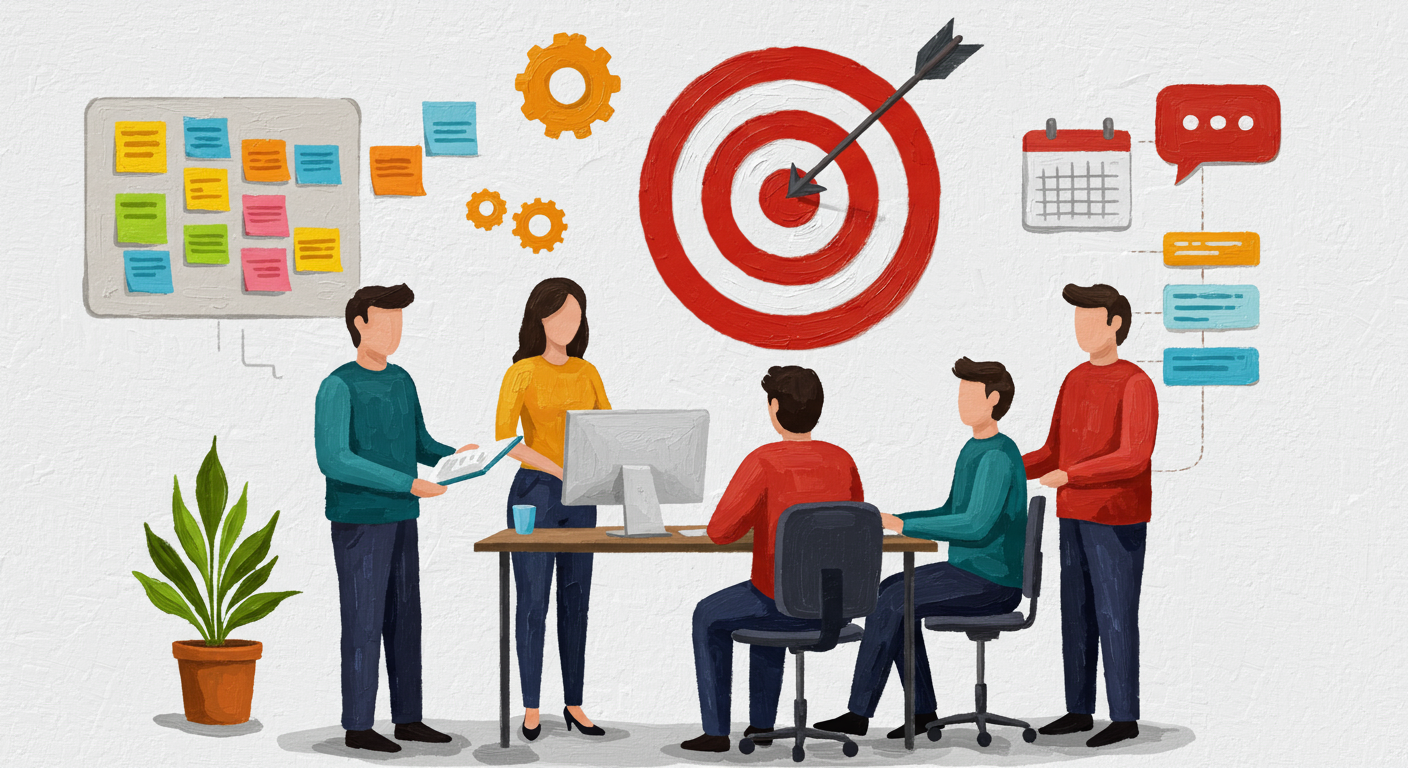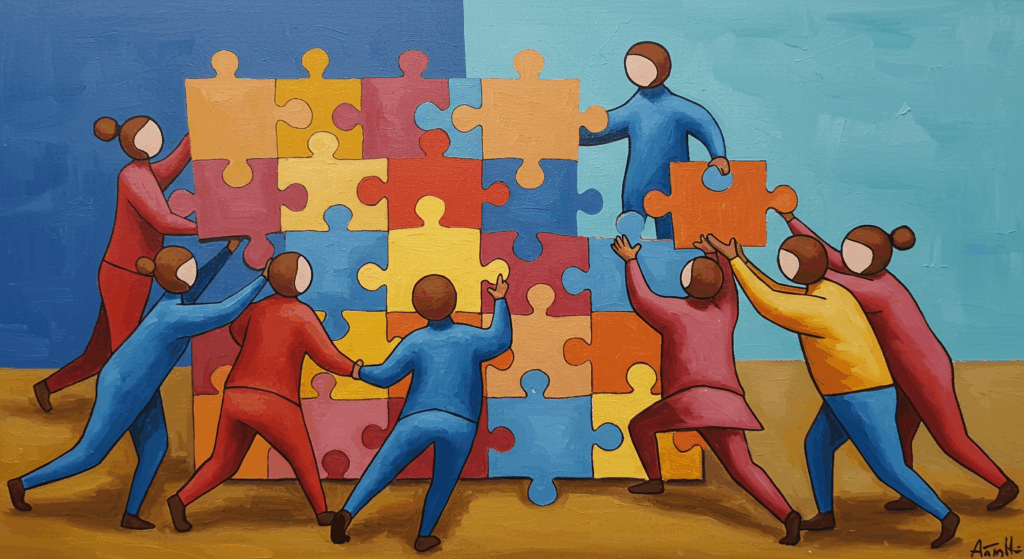A lot of “team building” feels like being trapped in a meeting that someone tried to disguise with snacks. If you’ve ever sat through trust falls that made you trust literally no one, or a forced “fun” event that just made your Slack DMs spicy with complaints… yeah, same. The good news: it doesn’t have to be like that. You can design team exercises, group tasks, and collaborative games that don’t just entertain for an hour but actually make your team better at, you know, teaming.
This guide is part practical blueprint, part friendly pep talk. I’ll show you exactly how to plan, run, and debrief teamwork activities that fit your people, your goals, and your budget. We’ll talk outcomes (not just vibes), what to do with remote/hybrid crews, how to keep introverts safe, and how to measure whether anything worked. Sprinkle in a few slightly chaotic jokes and a couple “ngl” moments because we’re human. Cool? Cool.
Start With the Why (Like, Seriously)
Before you pick a game, pick a reason. The most common mistake is grabbing a random activity because it sounded fun on TikTok. Fun is great, but intentional fun unlocks results. Ask:
- What skills or behaviors do we want to strengthen in the next 30–90 days?
- What’s actually blocking collaboration right now?
- If this activity worked perfectly, what would people do differently at work next week?
Choose one or two outcomes (max!) for each session. Examples:
- Communication clarity (fewer misreads, more listening)
- Trust & psychological safety (people feel okay to ask “dumb” questions)
- Cross-functional alignment (PMs and engineers stop playing calendar Twetris warfare)
- Problem-solving (faster experiments, less analysis paralysis)
- Creativity & adaptability (especially when plans go poof)
Once you’ve got your outcomes, then pick your team exercises, group tasks, or collaborative games that fit. Not the other way around.
Know Your People (Audience First, Activities Second)
Your activity design should match your team’s energy, size, and context. Quick “get-to-know” grid:
- Where is your team? In-person, remote, hybrid, different time zones?
- Size & roles: 4–8 is perfect for deep collaboration. 12+ needs subgroups.
- Energy state: Burned out post-launch? Monday morning yawns? Post-lunch slump? (Protect the nap window.)
- Psych safety level: Do folks already share openly, or is it more… cautious?
- Accessibility needs: Mobility, sensory sensitivities, language differences, neurodiversity. Design so everyone can participate without stress.
- Competition tolerance: Some teams love leaderboards. Others spiral if you add a timer. Know the vibe.
Try a 2-minute poll first (anonymous if possible): “What would make this worthwhile for you?” The answers guide difficulty, timing, and tone. (Also: snacks. Snacks guide everything.)
The 5-Part Activity Arc (Make It Flow)
Great sessions feel like a mini story. Use this simple arc:
- Hook (2–5 min): Set context in plain language. Why this, why now, why it matters to real work. Quick, friendly, no corporate jargon soup.
- Ramp-up (5–10 min): A light warm-up (micro icebreaker) to get voices in the room. Keep it optional and low-risk.
- Core Challenge (20–45 min): The main team exercise / group task / collaborative game designed to hit your outcome(s).
- Debrief (10–20 min): The magic part. Translate the experience into work lessons. Guide reflection. Don’t skip.
- Transfer (5 min): Make one tiny commitment for the week (“From now on, we start standups with clarifying questions”). Put it in writing.
If you only remember one thing from this whole guide, remember the arc. Activities without debriefs are basically just office recess. (Fun! But not sticky.)
Rules That Spark Collaboration (Not Chaos)
Design mechanics that require teamwork, not just allow it:
- Interdependence: Give uneven information or unique roles so people must talk to complete the task.
- Meaningful constraints: Limited time, budget, or materials (but fair). Constraints fuel creativity.
- Role clarity: Assign roles like Facilitator, Timekeeper, Synthesizer, Reporter. Rotate midway so everyone flexes new muscles.
- Visible progress: A scoreboard, checklist, or kanban of milestones keeps momentum (and anxiety) in check.
- Inclusive options: Offer multiple ways to contribute—talking, writing, drawing, building, analyzing.
Ngl, nothing tanks an activity faster than unclear rules. Run a 60-second practice round so folks can fail safely before the real thing.
Psychological Safety: The Non-Negotiable
Make it normal—and safe—to take small risks. Set micro-agreements upfront:
- “We assume good intent.”
- “One mic at a time, no interrupting.”
- “Curious questions > hot takes.”
- “Pass is allowed—participation ≠ performance.”
Also, design silence as a feature. Give 60–90 seconds for quiet thinking or note-taking. Introverts will thank you. Extroverts will survive. Balance is healthy.
Logistics That Make or Break It
The small stuff is actually big stuff:
- Timeboxes: Shorter segments with quick resets beat one long slog. 5–15 minute “beats” feel snappy.
- Materials: Keep it simple—sticky notes, markers, timer, printed instruction cards. Remote? Shared docs + breakout rooms.
- Space: Room to stand/move is nice. But accessibility first—don’t force movement.
- Music: Light instrumental helps focus. Keep volume low. (No lyrical chaos during critical thinking, please.)
- Snacks & water: Science says hydration helps cognition. Anecdotes say gummies help morale.
Remote/hybrid tips:
- Assign a co-facilitator to watch chat/raised hands.
- Keep instructions visible on a shared doc at all times.
- Breakouts of 3–5 max, with roles assigned in the prompt.
- Record (with consent) the debrief only, not the play, to keep risk low.
The Debrief (Where Learning Actually Happens)
Use a simple structure: What? So What? Now What?
- What happened? Facts, feelings, surprises. (“We misread the clue. Twice.”)
- So what? What does that say about how we communicate, decide, or handle pressure?
- Now what? One behavior to try at work this week. Make it super small and specific.
Example debrief questions:
- “Where did we make meaning out of thin air?”
- “Who spoke least—what did we miss from them?”
- “What’s a signal we can watch for in meetings that a decision isn’t clear?”
Capture answers in a shared space. Turn 1–2 insights into team norms.
Measuring Impact Without Killing the Joy
You don’t need a PhD in data, just simple signals:
- Pulse survey (3 Qs, pre/post): Confidence in collaboration (1–5), clarity in communication (1–5), psychological safety (1–5).
- Behavioral metrics (4–8 weeks): Fewer Slack back-and-forths before decisions; faster PR reviews; more people contributing in standups; fewer “who owns this?” moments.
- Short retro: “What helped? What to change? What stuck at work?” Keep it to 10 minutes.
Share trends, not scores. This is about improvement, not report cards.
10 Plug-and-Play Team Exercises, Group Tasks & Collaborative Games
These are ready to run. Pick one that matches your outcome and team size. Each includes time, group size, materials, how-to, and debrief prompts. Adapt freely.
1) The Constraint Tower
Outcome: Communication clarity, rapid iteration
Time: 25–35 min
Group: 4–6
Materials: 20 sticks/straws, tape, string, 1 marshmallow (or random weight)
How it works: Build the tallest free-standing tower that can hold the marshmallow for 5 seconds. Halfway through, introduce a twist: mute the “leader,” or switch the timekeeper into facilitator.
Debrief: Who clarified assumptions? When did we over-explain vs. under-explain? What habit from this can we use in sprint planning?
2) Silent Line-Up (Remote-Friendly)
Outcome: Non-verbal collaboration, planning
Time: 15–20 min
Group: 6–12 (split if larger)
Materials: None (in person) or chat/whiteboard (remote)
How it works: In total silence, line up by birthday/month, or years of experience. Remote: arrange tiles in a shared board with initials.
Debrief: How did we communicate without words? What signals helped? Where did we assume?
3) Lost at Sea (Prioritization Game)
Outcome: Decision-making, consensus building
Time: 30–40 min
Group: 4–6
Materials: List of 15 survival items to rank
How it works: Individuals rank items first, then as a team. Compare differences and create one final list.
Debrief: Where did expertise emerge? Who shifted opinioins and why? How can we avoid “the loudest wins” at work?
4) Back-to-Back Drawing
Outcome: Clarity of instructions, feedback loops
Time: 20–25 min
Group: Pairs
Materials: Simple images, paper, pens
How it works: One person describes an image; the other draws without seeing it. Round two: the drawer can ask questions.
Debrief: How did questions change the outcome? At work, when should we ask for clarification vs. push forward?
5) The 5-Minute Startup (Collaborative Pitch)
Outcome: Creative problem-solving, role clarity
Time: 30–40 min
Group: 4–6
Materials: Prompt cards (“Build an app for X,” “Design a service for Y”)
How it works: Teams create a quick product concept and 60-second pitch. Roles: PM, Designer, Engineer, Customer.
Debrief: What made our pitch coherent? What role gaps slowed us down? Translate this to real project kickoffs.
6) Emoji Retrospective (Remote MVP)
Outcome: Emotional check-in, shared understanding
Time: 10–15 min
Group: Any
Materials: Shared doc/board
How it works: Everyone drops 3 emojis to describe this week. Group patterns.
Debrief: What themes do we notice? Any “silent fires”? What support would help?
7) Map the Mess (Process Untangle)
Outcome: Systems thinking, alignment
Time: 40–60 min
Group: 5–8
Materials: Big whiteboard/post-its
How it works: Map a real messy workflow (e.g., onboarding). Identify bottlenecks and handoffs. Propose one 10% improvement.
Debrief: Which handoff costs us most? What’s our first micro-experiment?
8) Photo Scavenger Hunt (Asynchronous)
Outcome: Connection, creativity
Time: 3–5 days async + 15-min share
Group: Any
Materials: Shared channel/thread
How it works: Prompt list: “your WFH buddy,” “a view that calms you,” “something that represents problem-solving.” People post when convenient.
Debrief: What did we learn about each other? Any norms we want to borrow (e.g., meeting walks)?
9) Customer Journey Remix
Outcome: Empathy, cross-functional collaboration
Time: 45–60 min
Group: 5–7
Materials: Journey map template
How it works: Map a customer’s path. Each person adds pain points and quick fixes from their role’s POV.
Debrief: Where do we unintentionally pass the pain? What’s one fix we can ship this sprint?
10) Escape the Inbox (Puzzle Sprint)
Outcome: Pattern recognition, calm under pressure
Time: 30–45 min
Group: 4–6
Materials: A set of puzzles or clues hidden in “emails”
How it works: Teams solve clues that unlock the next “email” until they “clear the inbox.”
Debrief: Who did what under time pressure? Did we swarm or split? What’s our default crisis mode—and is it helpful?
Designing Your Own: From Idea to Run-Sheet in 20 Minutes
Use this quick canvas to build custom team exercises, group tasks, or collaborative games:
- Outcome: (pick 1–2) e.g., “Faster consensus on priorities.”
- Constraint: Time (30 min), Remote (yes), Budget (zero), Group (6).
- Mechanic: Interdependence through roles + limited info.
- Prompt: One sentence that feels real, not academic.
- Materials: Keep to 3 items max.
- Run-Sheet:
- Hook (2 min)
- Instructions (3 min)
- Round 1 (8 min)
- Twist / Role Switch (5 min)
- Round 2 (8 min)
- Debrief (10 min)
- Debrief Qs: What worked, what broke, what we’ll try this week.
If it takes more than 20 minutes to plan, you’re probably overcomplicating it. Simple scales.
Sample Agendas You Can Steal
60-Minute “Communication Tune-Up”
- Hook: why this matters (2)
- Warm-up: Emoji Retrospective (10)
- Core: Back-to-Back Drawing (20)
- Debrief: What/So What/Now What (15)
- Transfer: one micro-commitment (5)
- Buffer (8) for tech hiccups/late joins
Half-Day “From Silos to Squad”
- Icebreaker: Silent Line-Up (15)
- Map the Mess (60)
- Break (10)
- The 5-Minute Startup (45)
- Lunch (30)
- Customer Journey Remix (60)
- Debrief + Action Board (20)
Hybrid “Remote Energy Refresh” (90 min)
- Hook + norms (5)
- Photo Scavenger Hunt gallery walk (15)
- Lost at Sea in breakouts (35)
- Debrief (20)
- Action commitments in shared doc (10)
- Flex buffer (5)
Common Pitfalls (And How to Fix Them Fast)
- Dominant voices take over: Add a “round-robin” rule. Use talking tokens (each person gets two). Rotate facilitator mid-activity.
- Low energy / eye-rolls: Shorten segments. Add a twist halfway. Switch from competitive to cooperative (shared target).
- Unclear instructions: Provide a one-pager visible at all times. Do a 60-second demo round. Ask someone to repeat back the goal.
- Too competitive = stressed team: Replace leaderboards with collective milestones. Celebrate “aha” moments, not winners.
- Tech chaos (remote): Assign a tech host. Put links in one doc. Share a backup plan (e.g., if Miro dies, switch to Google Docs).
- Safety flags: Always allow “pass.” Avoid physical tasks that could embarrass or exclude. No surprise recordings.
- No debrief (the cardinal sin): Timebox the core to protect the debrief. Even 8 munutes is better than zero.
Inclusivity & Accessibility (Design with Care)
- Provide written and spoken instructions.
- Offer alternatives to movement (seated versions).
- Avoid loud audio and flashing visuals.
- Watch time zones; rotate meeting times across regions.
- Keep language simple, avoid idioms that won’t translate.
- Let people opt out of photos and personal sharing.
- Food? Label allergens and include non-alcoholic options (sparkling water supremacy).
When in doubt, ask: “What would make this more comfortable for you?” Then actually do it.
Remote & Hybrid: Make Distance Disappear
You can do most group tasks and collaborative games online with light tweaks:
- Breakout rooms of 3–4 maximize participation.
- Visible roles in the meeting title: “Room 2—Nia (Facilitator), Rizal (Time), Jonah (Scribe).”
- Shared canvas (doc/board) with prompts, timers, and debrief Qs on page 1.
- Chat as a second channel: Ask folks to drop quick thoughts there; call out themes verbally.
- Frequent mini pauses: 30-second breathing/eyes-off-screen breaks every 15–20 minutes. (Your eyeballs will cheer.)
Async options are underrated: photo hunts, idea threads, “challenge of the week,” or micro-prompts in a channel (“Name one thing you misunderstood this week and how you fixed it”).
Safety, Privacy, and Boundaries
- Avoid activities that require touching or physical daring. (No “close your eyes and fall” nonsense. We have HR for a reason.)
- Respect privacy. Don’t force personal trauma sharing disguised as “authenticity.”
- Tell people if you’re recording, and ideally… don’t record the play part.
- Keep photos opt-in. Share them only in internal spaces—with captions, not callouts.
Budget-Friendly Doesn’t Mean Boring
- Index cards + pens = 80% of workshop magic.
- Reuse common office items for builds (paper, tape, spaghetti—seriously).
- Crowdsource prompts from your team. People love seeing their ideas get picked.
- Rotate facilitation—level people up by letting them run segments.
If you do have budget, spend it on time (planning, facilitation, debrief), not swag. (Unless the swag is snacks, in which case… yes.)
Make It Stick at Work (Otherwise Why Bother)
Fun memory → behavior change = Follow-Through.
- Action board: In the last 5 minutes, everyone writes one tiny behavior to try this week. Post it in a shared doc.
- Public check-ins: 10-minute follow-up next week: “What did you try? What happened?”
- Nudges: Schedule two reminders (“Ask one clarifying question in standup today”). Gentle, not naggy.
- Ritualize: Borrow a practice for recurring meetings (e.g., “2-minute silent think before decisions” or “roles visible in agenda”).
Treat teamwork like the gym: small consistent reps beat a once-a-year marathon.
Three Ready-Made Mini Programs
1. Program A: Communication & Clarity (4 weeks)
- Week 1: Back-to-Back Drawing + debrief
- Week 2: Emoji Retro + “Question Before Statement” norm
- Week 3: Lost at Sea + decision checklist
- Week 4: Map the Mess + commit one process fix
2. Program B: Trust & Safety (3 weeks)
- Week 1: Silent Line-Up + safety agreements
- Week 2: Photo Scavenger Hunt (async) + appreciation circle
- Week 3: Constraint Tower + “oops/aha” share
3. Program C: Cross-Functional Flow (4 weeks)
- Week 1: Customer Journey Remix
- Week 2: The 5-Minute Startup
- Week 3: Escape the Inbox
- Week 4: Retro & action board
All are adjustable for remote or in-person. Keep sessions to 60–90 minutes. Snack budget optional but recommended. (Gummies. Always gummies.)
Naming Helps (Yes, Really)
Calling something “Team Building Session 7” screams corporate. Rename your team exercises, group tasks, and collaborative games with fun, tiny-weird titles: Signal Boost, Map the Mess, Pitch in a Pinch, Stack Attack, Inbox Escape. People show up more curious when the name sounds like a playlist track.
Quick Checklist (Print This, Paste It, Tattoo It—Kidding)
- Clear outcomes (1–2)
- Right-sized groups (3–6 per breakout)
- Psychological safety norms
- Simple materials + visible instructions
- Interdependence built into the activity
- Practice round (1 min)
- Timeboxes + buffer
- Debrief questions ready
- One tiny transfer action
- Follow-up nudge scheduled
If all boxes are checked, you’re 90% there.
FAQ But Make It Chill
What if people hate games?
Don’t call them games—call them “work simulations” or “problem sprints.” Reduce gimmicks, increase relevance.
What about introverts?
Offer silent think time, typed contributions, and pairs before plenary. Let people pass. They’ll often come back with gold later.
How often should we run these?
Light and frequent > heavy and rare. Even 20-minute collaborative games monthly beat an annual offsite in long-term effect.
Can we measure ROI?
Track one friction metric (e.g., cycle time from idea → decision) before/after a 6-week series. Pair with pulse scores. Share trends, not targets.
Wrap-Up: Build Together, Don’t Perform Together
Teamwork activities aren’t about proving you’re a “fun” manager or staging a perfect scene for Instagram. They’re about practicing better ways to work—safely, playfully, and on purpose. Start small, simplify ruthlessly, and let your people surprise you. Because they will.
Try one thing this week—a 15-minute group task, a tiny debrief, a single norm you’ll actually use—and watch how the room (or Zoom) shifts. You’ve got this. Now go build something your team will remember for the right reasons.
Your move: Pick one activity from this guide and schedule it for next week. Drop me a note with your outcome, and I’ll help you tweak it into an even sharper fit for your crew. Let’s make collaboration less cringe and way more effective.









